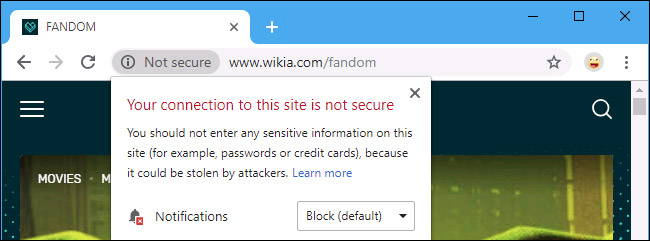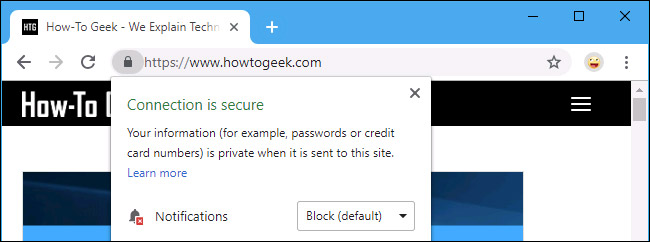Connecting over HTTPS is not necessarily safe
In fact, Google also now warns that unencrypted HTTP sites are 'Not secure'. So the question is why there are still so many problems such as malware, phishing scams and many other dangerous activities that happen day by day, with no sign of deterioration, regardless of the How is HTTPS in common use?
'Secure' sites only need a secure connection
If you pay attention, you will notice that Chrome often displays the word 'Secure' and a green padlock icon in the address bar when you visit a website using the HTTPS protocol. Or later modern versions of Chrome simply show a little gray padlock icon here, without the word 'Secure' anymore.
However, the word "Secure" gradually ceases to be used by Google on Chrome because it is somewhat misleading. This word "Secure" makes users understand that Chrome appears to confirm that the content of the website and that everything displayed on the site is "safe". But in reality, that's not true at all. A 'Secure' HTTPS website can still be completely full of malware or even a phishing or fake website.
In simple terms, HTTPS just shows you are accessing a secure connection, but does not guarantee that the website you visit is absolutely secure.
HTTPS prevents theft and tampering
HTTPS is great, but it doesn't have the 'magic' to make everything 100% secure. HTTPS stands for Hypertext Transfer Protocol Secure. It's like the standard HTTP protocol for connecting to websites, but with an added layer of secure encryption.
This encryption layer prevents crooks from tracking your data in transit, and also prevents man-in-the-middle attacks from interfering and modifying. website when it is delivered to you. For example, no one can snoop on the payment details you send to a website that uses HTTPS.

In short, HTTPS ensures the connection between you and a particular website is secure. No one can 'peek' or fake it.
This doesn't mean that HTTPS websites are "secure".
There is no denying the benefits of HTTPS, and all websites should use it. However, with that said, that just means you're using a secure connection to a particular website. The word 'Secure' here doesn't say anything about the content of the website at all, it just means that the site operator has purchased the certificate and set up encryption to secure the connection.
For example, a dangerous website filled with malicious downloads can still be sent over HTTPS. All that means the website and the files you download are sent over a secure connection, but they might not be secure themselves.

Similarly, a criminal can buy a reputable domain name like 'bankoamerica.com', obtain an SSL encryption certificate for it, and mimic the real Bank of America website. This will be a phishing site with a "safe" padlock icon when you visit it on Chrome, but in reality this just means that you have a secure connection to that phishing site.
After all, however, the popularity of HTTPS is still having a lot of positive impacts on the Internet world!
According to Google statistics, 80% of websites visited in Chrome on Windows are loaded over HTTPS. And Chrome users on Windows have also spent 88% of their web browsing time on HTTPS sites.
This popularity makes criminals less likely to compromise personal data and privacy, especially on public WiFi connections or general public networks. At the same time, internet users will significantly reduce the chances of encountering intermediary attacks.
This is partly because HTTPS is now considered the new base standard. Everything must be secure by default, so Chrome only warns you that the connection is 'Not Secure' when you visit a website over an HTTP connection.
You should read it
- Instructions for setting up HTTPS for simple websites
- How does setting HTTPS affect SEO?
- How to turn on HTTPS for your blog site
- How to enable DNS over HTTPS for all apps in Windows 10
- Enable DNS over HTTPS for apps on Windows 10
- How to enable DNS over HTTPS in Chrome, Edge and Firefox
- What's the difference between HTTP and HTTPS?
- Microsoft considers supporting DNS over HTTPS (DoH) directly in Windows 10
May be interested
- What's the difference between HTTP and HTTPS?
 you probably already know https as an enhanced form of http . however, do you already know the difference between http and https ? if not, let's find out with tipsmake.com!
you probably already know https as an enhanced form of http . however, do you already know the difference between http and https ? if not, let's find out with tipsmake.com! - Enable DNS over HTTPS for apps on Windows 10
 how do i enable dns over https on windows 10? what is dns over https? how does dns over https on windows 10 help secure information while surfing the web?
how do i enable dns over https on windows 10? what is dns over https? how does dns over https on windows 10 help secure information while surfing the web? - The default navigation protocol on Google Chrome is coming to be HTTPS
 this change will be officially applied starting with the next (stable) update of the desktop and android versions of chrome browsers.
this change will be officially applied starting with the next (stable) update of the desktop and android versions of chrome browsers. - What is HTTPS? Why is it needed for your website?
 you often visit a website and see https but don't understand what it is and how it is different from http, so read the following article!
you often visit a website and see https but don't understand what it is and how it is different from http, so read the following article! - How to enable DNS over HTTPS in Chrome, Edge and Firefox
 dns over https encrypts dns lookup to increase privacy. here's how to turn on dns over https in chrome, edge and firefox.
dns over https encrypts dns lookup to increase privacy. here's how to turn on dns over https in chrome, edge and firefox. - All problems with starting Windows in Safe Mode
 safe mode is a mode that helps windows to boot with minimal devices and services so that it can diagnose what is wrong with windows and fix the error.
safe mode is a mode that helps windows to boot with minimal devices and services so that it can diagnose what is wrong with windows and fix the error. - Microsoft considers supporting DNS over HTTPS (DoH) directly in Windows 10
 microsoft has issued a confirmation message that it will enable dns over https for windows 10 support.
microsoft has issued a confirmation message that it will enable dns over https for windows 10 support. - What is HTTPS? Benefits of using HTTPS protocol
 https (hypertext transfer protocol secure) is a secure hypertext transfer protocol that helps increase website security.
https (hypertext transfer protocol secure) is a secure hypertext transfer protocol that helps increase website security. - Cloudflare introduces tools to detect new HTTPS blocking
 cloudfare has recently released 2 new tools designed to simplify the process of checking whether tls connections to the website are blocked.
cloudfare has recently released 2 new tools designed to simplify the process of checking whether tls connections to the website are blocked. - How to use the Safe Boot option of Mac
 apple has provided the safe boot option (sometimes called safe mode) since jaguar (os x 10.2.x). safe boot may be the main troubleshooting step when you encounter problems with your mac.
apple has provided the safe boot option (sometimes called safe mode) since jaguar (os x 10.2.x). safe boot may be the main troubleshooting step when you encounter problems with your mac.










 What is Teardrop attack?
What is Teardrop attack? How to set up IKEv2 IPsec on Windows
How to set up IKEv2 IPsec on Windows 5 reasons why you should use a firewall
5 reasons why you should use a firewall How does visiting an 'adult' website harm security and privacy?
How does visiting an 'adult' website harm security and privacy? What is Side-Channel Attack (SCA)?
What is Side-Channel Attack (SCA)? How to use Media Lock to hide files on Windows 10
How to use Media Lock to hide files on Windows 10